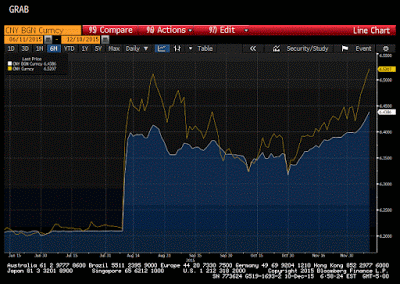China was instructed by the IMF that as an operational requirement for joining the SDR the gap between the onshore and offshore yuan (CNY and CNH respectively) needed to close. This was important for central banks to hedge. The opposite is taking place.
That is what this Great Graphic, created on Bloomberg depicts. The yellow line is CNH. The white line is CNY. When PBOC facilitated a mini-devaluation in August, the spread widened out. However, in September and October, as it became clearer that Chinese officials were not looking to take a “second bite of the cherry”, the yuan drifted higher and the gap closed.

Then starting in early November, the yuan trended gently lower. It depreciated by 1.25% over the course of the month. Note this is prior to the announcement of the IMF’s decision, which took place on the last day of the month. The onshore yuan has depreciated by 0.6% here in December. The offshore yuan has fallen twice as much. To some extent, it is part of a self-reinforcing cycle.
The onshore yuan falls and some will “wager” that it will continue to fall by selling CNH, which is freely accessible in a way that CNY is not. Other investors with Chinese exposure, may decided to hedge the currency risk, given divergence and other considerations, and will use the offshore market for accessibility as well.
This will be a hard circle to break. It appears that the PBOC has tried to intervene to support CNH either directly and/or indirectly through policy banks. As other central banks have learned, intervention in the currency markets rarely has more than a short-lived impact if it is going against market trends and does not signal a more supportive monetary policy. China has taken other measures, perhaps best thought of as soft capital controls to limited outflows from the mainland.
It also appears that part of the funds leaving China are going to Hong Kong, a Special Administrative Region. This is keeping the Hong Kong dollar up against the official cap, keeping the Hong Kong Monetary Authority watching it vigilantly. We have often argued that part of what is perceived to be the internationalization of the yuan is really the Sino-ification of China. That is to say that some of the measures that are said to depict the use of the yuan outside of China are distorted by the inclusion of Hong Kong. It is important to take it account in terms of capital flows as well.













Leave A Comment